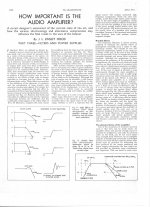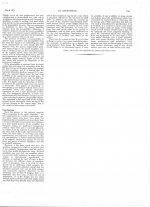Does it seem viable that the market wants another phonograph high pass filter?
Having got quite into the subject, it appears to me that very little has actually been written about rumble filters, of the conventional as well as the anti-phase-cancelling types.
Perhaps I should change that.
Yes but the material your listening to IS NOT and doesnt sound as nice.....
Why doesn't it, its higher resolution, quieter etc. Am I missing something here?
Without wishing to stray too far OT, but thinking about things that are not there, one of the problems for those not willing to splash out for the likes of the AT150Mlx is that there is a distinct resonant peak around 16KHz. Some attempts have been made to come up with a better MM stage, but nothing to deal with the high frequency problems. One could argue that MC has won the hi-fi race, but looking at it dispassionately MM/MI should be a better solution if you get the interfacing right. Deep dive is another topic, but worth considering in a discussion of 21st century vinyl interfacing...
[/offtopic]
[/offtopic]
Having got quite into the subject, it appears to me that very little has actually been written about rumble filters, of the conventional as well as the anti-phase-cancelling types.
Perhaps I should change that.
Definately !
I'm sure that JLH did something on this subject, but cant seem to remember where/when; possibly in 'the Gramophone' or have I imagined it ?
Definately !
I'm sure that JLH did something on this subject, but can't seem to remember where/when; possibly in 'the Gramophone' or have I imagined it ?
The only one that comes immediately to mind is a design from "Modular Preamplifier Part 2" in Wireless World Nov 82. It uses no known filter structure.
It has a 0.6 dB peak before turnover, and has a response sagging unhappily by 1dB between 60 and 200Hz. It claims to be 3rd-order but the slope is only 12dB/octave below 20 Hz.
I'm afraid it is a typical JLH filter 'design'.
Sorry the quality is pretty poor (I nearly said something else!)
I've only got them as gifs; I tried pdfing them and it was worse!
I've only got them as gifs; I tried pdfing them and it was worse!
Thanks, for that.
I've have found a JLH article, with a brief mention of rumble filters, attached (hopefully)
Thanks for providing that- I'd not see it before.
Unfortunately it gives very little info, and ignores the anti-phase signals due to vertical motion, which is what this thread is largely about.
Douglas;
How do you isolate vertical motion? With stereo phonograph record, each groove wall produces both vertical and horizontal stylus displacement.
How do you isolate vertical motion? With stereo phonograph record, each groove wall produces both vertical and horizontal stylus displacement.
Douglas;
How do you isolate vertical motion? With stereo phonograph record, each groove wall produces both vertical and horizontal stylus displacement.
Subtract the two channels. Most of this thread relates to that process.
Barley
Horizontal motion of the stylus reads the in-phase signal.
If you add the two stereo channels you are effectively reading the horizontal motion.
Vertical motion of the stylus reads the out of phase signal and also the difference between the two channels.
If you subtract the two stereo channels you are effectively reading the vertical motion.
Ignoring noise, if you have two identical signals in the groove, then you have ONLY horizontal motion of the stylus. There will be no vertical motion and the difference signal will be zero (except for that noise).
Horizontal motion of the stylus reads the in-phase signal.
If you add the two stereo channels you are effectively reading the horizontal motion.
Vertical motion of the stylus reads the out of phase signal and also the difference between the two channels.
If you subtract the two stereo channels you are effectively reading the vertical motion.
Ignoring noise, if you have two identical signals in the groove, then you have ONLY horizontal motion of the stylus. There will be no vertical motion and the difference signal will be zero (except for that noise).
A+B = horizontal motion and A-B = vertical motion. This is ridiculous. To see this, just think about applying this to two arbitrary signals. What does this methodology tell you when applied to a CD or tape?
If low frequencies are recorded in mono, then A+B delivers a few dB improvement of S/N for low frequencies. This requires foreknowledge of how record is made.
If low frequencies are recorded in mono, then A+B delivers a few dB improvement of S/N for low frequencies. This requires foreknowledge of how record is made.
Hi Barleywater,
I think you would do well to first understand the basic principles of vinyl disc modulation as illustrated in this link,
How to pack a stereo signal in one record groove
See the 3rd from last and last illustrations to understand how A+B= lateral motion and A-B=vertical motion.
Peter
I think you would do well to first understand the basic principles of vinyl disc modulation as illustrated in this link,
How to pack a stereo signal in one record groove
See the 3rd from last and last illustrations to understand how A+B= lateral motion and A-B=vertical motion.
Peter
Nice gifs. They illustrate my points exactly. With stereo recording both groove walls induce vertical and horizontal motion stylus. These can not be separated out with A+B and A-B treatments with unknown content.
Barleywater: you are desperately trying to find cracks that support your belief. A more productive stance its to desperately try to understand what everybody is trying to tell you.
Just my € 0.02
Jan
Just my € 0.02
Jan
Does your CDP have a stylus wiggling in a groove?Jan;
What does applying A+B and A-B to output of CD player tell you?
I don't think mine has!
You must remember that the Blumlein stereo was designed to be backwards compatible with monoJan;
What does applying A+B and A-B to output of CD player tell you?
- Status
- Not open for further replies.
- Home
- Source & Line
- Analogue Source
- Hypothesis as to why some prefer vinyl: Douglas Self

